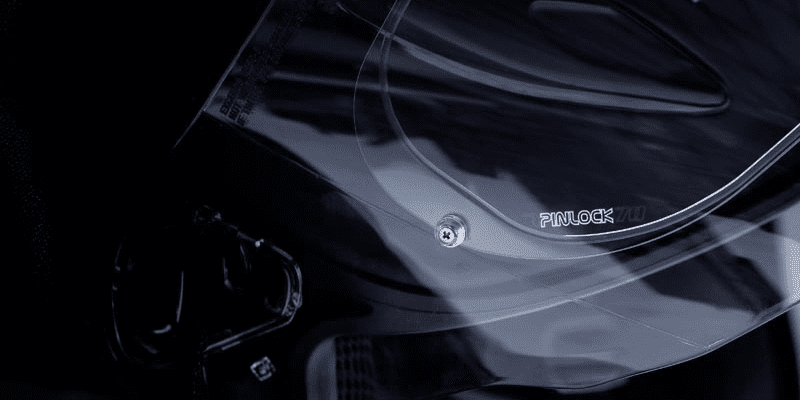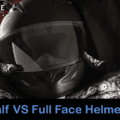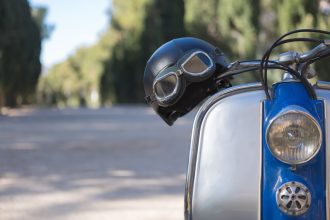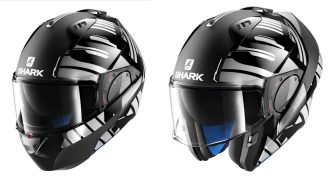Some of the most common considerations when purchasing or replacing a bike helmet is Air Circulation, Ventilation & Breathability for the rider.
Unfortunately, due in part to design elements some helmets do fog-up just a few minutes into a ride and this is something which could impair vision & compromise rider safety – increasing the risk of an accident.
So, with rider safety in mind, we’ve listed below a few methods & tips about how to demist your helmet and avoid this niggle that bike riders often experience.

The main cause of helmet fogging
Condensation is the main cause of helmet fogging (mist). Because the helmet encloses around your head, any air the rider exhales gets trapped inside as there is little space for all of it to escape.
During cold weather, the visor and glass get cold, and the warm air being exhaled directly onto the cold surface condenses on the glass thus causing fogginess.
The free area inside the helmet is small and your head occupies most of it so this leads to poor ventilation.

Helmets tend to fog up in bad weather, just when you need maximum visibility.
As you sweat, the sweat ends up condensing on the visor causing supersaturation and thus causing the fog or mist which significantly reduces visibility.
So, what can you do about? Below we list 13 different methods. Some are common sense, some are paid products and others are completely outside of the box.
Free solutions
1. Remove neck buffs or nose guards
To avoid sweating while riding ensure your helmet is well ventilated. To do this ensure to remove all the neck buffs so as to allow a freeway for exhaled air to escape through.
Some helmets come with a nose guard, which can be used to direct the exhaled air away from the visor.
2. Open all the vents

Having the helmet vents in the open position can help!
Ensure that all vents are open to optimize ventilation.
3. Regularly open the visor:
Another hack to cure helmet fogging is opening your visor whenever you make a stop. When you stop for gas or traffic lights, be ensure to open your visor.
This improves the ventilation because of the fresh supply of air.
This is easy enough to do as you are bound to make many stops during a city ride, likewise a long haul journey should always include a few comfort stops to refresh & recuperate.
4. Open the visor a fraction
You can also keep the visor open at a small angle. This creates another path for the exhaled air to escape and prevents it from condensing on the visor.
Some helmets are fitted with a lever which enables one to open the visor without running the risk of allowing rain in or of the visor closing off completely.
5. Wear a neck tube
Wear a neck tube up and over your nose and mouth. The neck tube serves as a pathway for exhaled air and supply of fresh air as the other end will be free and in the open air.

Wearing a head sock, bandanna or mask really works well
Commercial solutions
6. Use the pin lock system:
A pin lock is essentially a second visor fitted on the inside of your main visor. The essence of this is to keep it warm, so it’s not affected by the outside weather conditions.
The pin lock and the main visor should be kept airtight so that the air in between the pin lock and the main visor being a good insulator ensures the pin lock stays warm and therefore the exhaled air does not condense on it.
Pin locks are available commercially and you can fit them onto your main visor easily. Ensure to purchase a helmet that has a pin lock designed for it.
For helmets that don’t have a pin lock designed, a fog stop is available and this is designed to stick on the inside of any visor and works just as well the visor itself.

7. Use Anti-fogging lenses:
These are lenses that have been treated with anti-fogging agents to prevent condensation and formation of small water droplets. Visors can thus be treated with the anti-fog agents.
8. Use Anti-fog sprays
Spray the anti-fog spray on your visor before any journey. You could also have a no-fog lens cloth and wipe your visors with them. All these are relatively cheap and work fine.
9. Using Anti-fog treatments
Fogtech is applied by wiping a thin, transparent layer on the inside of the visor carefully so as not to leave any streaks which may hinder visibility further.
These treatments work in a way that once you have coated your visor, the carrier evaporates and a thin coat of hydrophilic chemicals is left and surfactant.
The hydrophilic portion soaks up the water produced when exhaled air condenses on the visor and the surfactant spreads it so evenly and so thin that it is transparent.
It’s relatively costly compared to other anti-fog agents, but it works well and lasts a good length of time.
You only need to apply a very thin coating, and the single coating can last for days.
10. Insert removable respiration masks:
There is a mask which can be worn over your mouth and nose. It’s made up of neoprene and fastened to the inside of the helmet to help guide away from the visor and glasses plus it’s a very affordable option too.
It also filters the fresh supply of air, preventing the rider from inhaling polluted air. The masks filter the moisture from the exhaled air, which would have condensed on the visor.
The masks are also removable and have a very good porosity making a normal breath cycle much simpler.

Wacky solutions
Ok, so not all Motorcyclists can afford to buy anti-fog agents, but a few wacky solutions exist to get through a few miles fog free.
However, they do not work so well like some of the above mentioned methods.
11. Breath through your nose
It might work in a pinch? Try breathing through your nose when you stop and when waiting for traffic lights.
However, this is not the best solution as the outside weather could be very extreme and you would not want to inhale the cold air.
12. A Hose between the vents
You can also use a hose. Insert a hose into the two vents of the helmet and then cut a hole in one section that is wide enough to fit your mouth.
The exhaled air will use this hole it as a pathway to the outside. This can be very uncomfortable and sort of tiring as you want to be free and be able to communicate since the hose means you will be biting something and you could get tired.
13. Upholstery polish
Upholstery polish could work too, but then it can only eliminate a small part of the problem. Even with an upholstery, you will still have a foggy visor.
The sprays used on fake leather seats and dashboards can work too.

Let’s throw some light on the problem!
So what’s the conclusion ?
Numerous ways of avoiding a misty helmet exist.
Some work exceptionally well, but they are quite expensive.
The few cheap ones don’t work quite as well and they can be a hassle to implement.
The best way is mainly the better known commercial options such as Pinlock or the use of fogtech or anti-fog agents.
Some of the other “free” methods work pretty well also, particularly the head sock or bandanna.
You should give them a try remembering of course that what worked exceptionally well for another person may not work very well for you.
That being the case, we would love to hear your feedback.
We hope you find this information helpful. If you would like to support this site, you can by purchasing through recommended links on the page. Should you decide to purchase, we may earn a small percentage of the sale at no cost to you.
Thank you for your support.
Looking for a Replacement Helmet? Here’s a Recommendation
| Best Full-Face Motorcycle Helmet | Price | Rating |
|---|---|---|
| 5/5 rubber chickens | ||
| 4.8/5 rubber chickens | ||




















